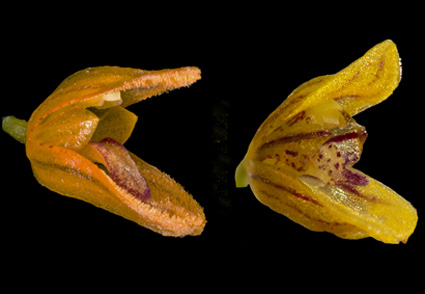Abstract
Distributed along the eastern coast of South America and considered one of the world’s biological hotspots, the Atlantic Rainforest harbors outstanding levels of richness and endemism (Myers et al. 2000). Specifically, with 14,847 vascular plant species (Reginato & Michelangeli 2020), including 1,480 (1,100 endemics) belonging to the Orchidaceae (BFG, 2015), this biome is considered a priority for plant and orchid conservation in the Neotropics since more than 88% of its pre-Columbian area is already lost (Peres et al. 2020).
References
Barros, F. (1983) Flora fanerogâmica da reserva do parque estadual das Fontes do Ipiranga (São Paulo, Brasil). Hoehnea 10: 74–124.
BFG—The Brazil Flora Group. (2015) Growing knowledge: an overview of seed plants diversity in Brazil. Rodriguésia 66: 1085–1113. https://doi.org/10.1590/2175-7860201566411
Brieger, F.G. & Senghas, K. (1976) Pabstiella eine neue Orchideengattung aus Brasilien. Die Orchidee 27: 193–196.
Brown, R. (1813) Pleurothallis. In: Aiton, W.T. (Ed.) Hortus Kewensis, (2nd ed.) 5. Taylor, London, pp. 211.
Campacci, M.A. (2019) Novas espécies e híbridos naturais. Coletânea de orquídeas brasileiras 15: 585–636.
Campacci, M.A. (2020) Novas espécies e híbridos naturais. Coletânea de orquídeas brasileiras 16: 637–680.
Carnaval, A.C. & Moritz, C. (2008) Historical climate modelling predicts patterns of current biodiversity in the Brazilian Atlantic forest. Journal of Biogeography 35: 1187–1201. https://doi.org/10.1111/j.1365-2699.2007.01870.x
Carnaval, A.C., Hickerson, M.J., Haddad, C.F., Rodrigues, M.T & Moritz, C. (2009) Stability predicts genetic diversity in the Brazilian Atlantic forest hotspot. Science 323: 785–789. https://doi.org/10.1126/science.1166955
Chiron, G.R & Bolsanello, R.X. (2012) Trois espèces nouvelles de Pabstiella (Orchidaceae, Pleurothallidinae) en Espírito Santo (Brésil). Richardiana 8: 109–123.
Chiron, G.R., Guiard, J. & van den Berg, C. (2012) Phylogenetic relationships in Brazilian Pleurothallis sensu lato (Pleurothallidinae, Orchidaceae): evidence from nuclear ITS rDNA sequences. Phytotaxa 46: 34–58. https://doi.org/10.11646/phytotaxa.46.1.5
de Fraga, C.N. & Kollmann, L.J.C (2010) Three new species of Pabstiella (Pleurothallidinae, Orchidaceae) from Brazilian Atlantic Forest. Harvard Papers in Botany 15: 171–178. https://doi.org/10.3100/025.015.0111
Gutiérrez Morales, N., Toscano de Brito, A.L.V., Mauad, A.V.S.R. & Smidt, E.C. (2021) Molecular phylogeny and biogeography of Pabstiella (Pleurothallidinae: Orchidaceae) highlight the importance of the Atlantic Rainforest for speciation in the genus. Botanical Journal of the Linnean Society 195: 568–587. https://doi.org/10.1093/botlinnean/boaa092
Hoehne, F.C. (1946) Novidades para as orchidaceas de S. Paulo e Parana. Arquivos de Botânica do Estado de São Paulo 2: 21–24.
Karremans, A.P. (2016) Genera Pleurothallidinarum: an updated phylogenetic overview of Pleurothallidinae. Lankesteriana 16: 219–241. https://doi.org/10.15517/lank.v16i2.26008
Lindley, J. (1835) Pleurothallis grobyi. Edwards’s Botanical Register 21: t. 1797.
Luer, C.A. (2007) Icones Pleurothallidinarum XXIX. A third century of Stelis of Ecuador and systematics of Apoda- Prorepentia and systematics of miscellaneous small genera, addenda: new genera, species, and combinations (Orchidaceae). Monographs in Systematic Botany from the Missouri Botanical Garden 112: 1–130.
Luer, C.A. & Toscano de Brito, A.L.V. (2011) Miscellaneous new species and combinations in the Pleurothallidinae (Orchidaceae) from Brazil and Argentina. Harvard Papers in Botany 16: 361–383.
Murray-Smith, C., Brummitt, N.A., Oliveira-Filho, A.T., Bachman, S., Moat, J., Lughadha, E.M.N. & Lucas, E.J. (2009) Plant diversity hotspots in the Atlantic coastal forests of Brazil. Conservation Biology 23: 151–163. https://doi.org/10.1111/j.1523-1739.2008.01075.x
Myers, N., Mittermeier, R.A., Mittermeier, C.G., Da Fonseca, G.A. & Kent, J. (2000) Biodiversity hotspots for conservation priorities. Nature 403: 853–858. https://doi.org/10.1038/35002501
Peres, E.A., Pinto-da-Rocha, R., Lohmann, L.G., Michelangeli, F.A., Miyaki, C.Y. & Carnaval, A.C. (2020) Patterns of species and lineage diversity in the Atlantic Rainforest of Brazil. In: Rull, V. & Carnaval, A.C. (Eds.) Neotropical diversification: patterns and processes. Springer, Cham, Switzerland, pp. 415–447. https://doi.org/10.1007/978-3-030-31167-4_16
Ponert, J., Portilla Andrade, M., Karremans, A.P., Chumová, Z. & Trávní?ek, P. (2021) A new species of Pabstiella (Pleurothallidinae, Orchidaceae) from Ecuador. Phytotaxa 500: 108–116. https://doi.org/10.11646/phytotaxa.500.2.3
Pupulin, F. (2020) Vanishing beauty. Native Costa Rican orchids, Vol. 2: Lacaena–Pteroglossa. Koeltz, Oberreifenberg.
Reginato, M. & Michelangeli, F.A. (2020) Bioregions of eastern Brazil based on vascular plant occurrence data. In: Rull, V. & Carnaval, A.C. (Eds.) Neotropical diversification: patterns and processes. Springer, Cham, Switzerland, pp. 475–494.
Swartz, O. (1799) Dianome epidendri generis Linn. Journal für die Botanik 2: 201–244.
Thomas, W.W., Carvalho, A.M.V.D., Amorim, A.M.A., Garrison, J. & Arbelaez, A.L. (1998) Plant endemism in two forests in southern Bahia, Brazil. Biodiversity and Conservation 7: 311–322. https://doi.org/10.1023/A:1008825627656
Toscano de Brito, A.L.V. & Luer, C.A. (2016) New species and nomenclatural notes in Pabstiella (Orchidaceae: Pleurothallidinae) from Brazil. Lankesteriana 16: 153–185.


